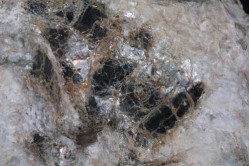|

Description
Mica, a common rock-forming mineral, is structured like hexagonal sheets. It has a perfect basal cleavage allowing thin springy sheets to be peeled away. Mica is a good insulator, and is heat resistant, corrosion resistant and chemically stable so it is often used in insulation and fire-proofing. The types of Mica minerals found in Taiwan include muscovite, biotite, phlogopite, paragonite and phengite. Muscovite with a fine, scaly-appearance and silk-like luster is also known as sericite. Another sub-type of muscovite is fuchsite which has a higher chrome content and appears as emerald flakes.
Muscovite is the only mica mineral of economic value in Taiwan. It is mainly found together with feldspar and quartz in the pegmatite between Nan-ao and Dong-ao in Yilan.
Mineral Formation
In Taiwan, mica is usually the product of hydrothermal alteration and is found mainly in pegmatite and metamorphic rock.
Geographic Distribution
(1) In pegmatite and gneiss between Su-ao in Yilan and Hualien
(2) In Siangyang area of Lidao Village in Haiduan Township, Taitung County
(3) In the Hornblende Schist at Damayen in Yuli, Hualien
(4) Sedimentary rock throughout Taiwan
Mining History
Along with quartz and feldspar, mica was mined in Fenniaolin at Dong-ao in Yilan County as early as 1922. During the Japanese colonial period mica was considered a strategic material so it was heavily mined by the Japanese and shipped to Japan. The Taiwan Mica Mining Company was set up in 1951 to mine mica, quartz and feldspar around the Danan-ao River. Mining operations ceased after the mica deposits ran out. As of 2007, the only large-scale producer of mica is the Sunshine Mineral Company operating at Lidao Village in Haiduan Township, Taitung. The main type of mica produced is sericite.
Production
In 1951 Mica production totaled 485,000 kg and peaked at 1.1 million kg in 1992.
In 2005, Taiwan's Mica production totaled 8,608,099 kg and in 2006 it totaled 4,841,210 kg.
Applications
Frequently used for insulation in electrical appliances as well as filler in engineering plastics, rubber and paint. It is also used in paper making, cosmetics, fire-proofing and thermal insulation.
Chemical Composition
Chemical composition of muscovite from fenniaolin.
National Museum of Natural Science
|